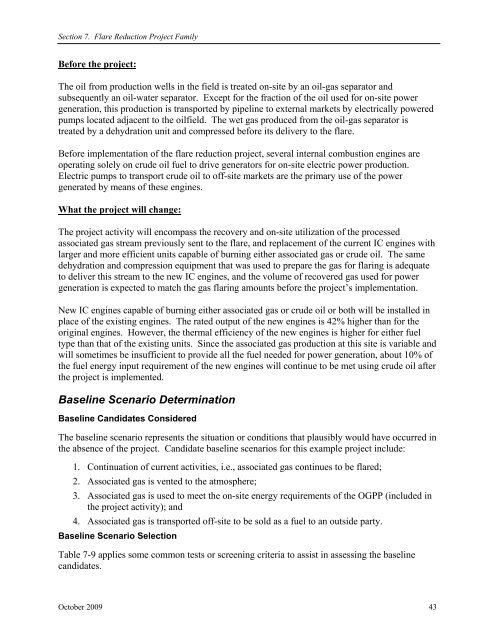Part III: Flare Reduction Project Family - IPIECA
Part III: Flare Reduction Project Family - IPIECA
Part III: Flare Reduction Project Family - IPIECA
Create successful ePaper yourself
Turn your PDF publications into a flip-book with our unique Google optimized e-Paper software.
Section 7. <strong>Flare</strong> <strong>Reduction</strong> <strong>Project</strong> <strong>Family</strong><br />
Before the project:<br />
The oil from production wells in the field is treated on-site by an oil-gas separator and<br />
subsequently an oil-water separator. Except for the fraction of the oil used for on-site power<br />
generation, this production is transported by pipeline to external markets by electrically powered<br />
pumps located adjacent to the oilfield. The wet gas produced from the oil-gas separator is<br />
treated by a dehydration unit and compressed before its delivery to the flare.<br />
Before implementation of the flare reduction project, several internal combustion engines are<br />
operating solely on crude oil fuel to drive generators for on-site electric power production.<br />
Electric pumps to transport crude oil to off-site markets are the primary use of the power<br />
generated by means of these engines.<br />
What the project will change:<br />
The project activity will encompass the recovery and on-site utilization of the processed<br />
associated gas stream previously sent to the flare, and replacement of the current IC engines with<br />
larger and more efficient units capable of burning either associated gas or crude oil. The same<br />
dehydration and compression equipment that was used to prepare the gas for flaring is adequate<br />
to deliver this stream to the new IC engines, and the volume of recovered gas used for power<br />
generation is expected to match the gas flaring amounts before the project’s implementation.<br />
New IC engines capable of burning either associated gas or crude oil or both will be installed in<br />
place of the existing engines. The rated output of the new engines is 42% higher than for the<br />
original engines. However, the thermal efficiency of the new engines is higher for either fuel<br />
type than that of the existing units. Since the associated gas production at this site is variable and<br />
will sometimes be insufficient to provide all the fuel needed for power generation, about 10% of<br />
the fuel energy input requirement of the new engines will continue to be met using crude oil after<br />
the project is implemented.<br />
Baseline Scenario Determination<br />
Baseline Candidates Considered<br />
The baseline scenario represents the situation or conditions that plausibly would have occurred in<br />
the absence of the project. Candidate baseline scenarios for this example project include:<br />
1. Continuation of current activities, i.e., associated gas continues to be flared;<br />
2. Associated gas is vented to the atmosphere;<br />
3. Associated gas is used to meet the on-site energy requirements of the OGPP (included in<br />
the project activity); and<br />
4. Associated gas is transported off-site to be sold as a fuel to an outside party.<br />
Baseline Scenario Selection<br />
Table 7-9 applies some common tests or screening criteria to assist in assessing the baseline<br />
candidates.<br />
October 2009 43

















